Related Research Articles
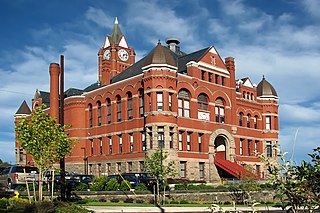
Jefferson County is a county located in the U.S. state of Washington. As of the 2020 census, the population was 32,977. The county seat and only incorporated city is Port Townsend. The county is named for Thomas Jefferson.

Quilcene is an unincorporated community and census-designated place (CDP) in Jefferson County, Washington, United States. The population was 596 at the 2010 census.

The Duwamish River is the name of the lower 12 miles (19 km) of Washington state's Green River. Its industrialized estuary is known as the Duwamish Waterway. In 2009, the Duwamish Longhouse and Cultural Center was opened on the west bank of the river as part of the tribe's reassertion of its historic rights in the area and its continuing struggle for federal recognition of tribal status.

The Olympic Peninsula is a large arm of land in western Washington that lies across Puget Sound from Seattle, and contains Olympic National Park. It is bounded on the west by the Pacific Ocean, the north by the Strait of Juan de Fuca, and the east by Hood Canal. Cape Alava, the westernmost point in the contiguous United States, and Cape Flattery, the northwesternmost point, are on the peninsula. Comprising about 3,600 square miles (9,300 km2), the Olympic Peninsula contained many of the last unexplored places in the contiguous United States. It remained largely unmapped until Arthur Dodwell and Theodore Rixon mapped most of its topography and timber resources between 1898 and 1900.
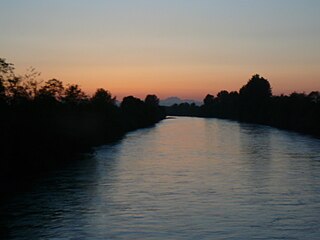
The Puyallup River is a river in the U.S. state of Washington. About 45 miles (72 km) long, it is formed by glaciers on the west side of Mount Rainier. It flows generally northwest, emptying into Commencement Bay, part of Puget Sound. The river and its tributaries drain an area of about 948 square miles (2,460 km2) in Pierce County and southern King County.
The Kitsap Peninsula lies west of Seattle across Puget Sound, in Washington state in the Pacific Northwest. Hood Canal separates the peninsula from the Olympic Peninsula on its west side. The peninsula, a.k.a. "Kitsap", encompasses all of Kitsap County except Bainbridge and Blake Islands, as well as the northeastern part of Mason County and the northwestern part of Pierce County. The highest point on the Kitsap Peninsula is Gold Mountain. The U.S. Navy's Puget Sound Naval Shipyard, and Naval Base Kitsap are on the peninsula. Its main city is Bremerton.
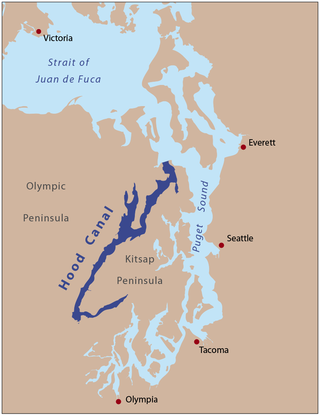
Hood Canal is a fjord forming the western lobe, and one of the four main basins of Puget Sound in the U.S. state of Washington. It is one of the minor bodies of water that constitute the Salish Sea. Hood Canal is not a canal in the sense of an artificial waterway—it is a natural feature.

The Napa River is a river approximately 55 miles (89 km) long in the U.S. state of California. It drains a famous wine-growing region called the Napa Valley, in the mountains north of the San Francisco Bay. Milliken Creek and Mt. Veeder watersheds are a few of its many tributaries. The river mouth is at Vallejo, where the intertidal zone of fresh and salt waters flow into the Carquinez Strait and the San Pablo Bay.

The Yolo Bypass is one of the two flood bypasses in California's Sacramento Valley located in Yolo and Solano Counties. Through a system of weirs, the bypass diverts floodwaters from the Sacramento River away from the state's capital city of Sacramento and other nearby riverside communities.
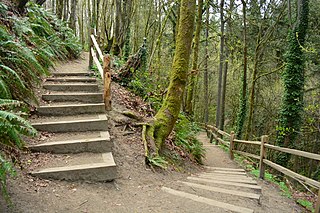
Puget Creek is a small urban creek in the U.S. state of Washington, in the north end of Tacoma, It rises in Puget Park and flows north to Commencement Bay, part of Puget Sound. Its course follows a steep ravine containing Puget Gardens Park. The creek's course is mostly contained within the 66-acre (270,000 m2) natural area of Puget Gulch. Puget Creek is the focus of restoration work by the Puget Creek Restoration Society and community volunteers. One of the restoration goals is the reestablishment of regular runs of coho and chum salmon, as well as sea-run coastal cutthroat trout.
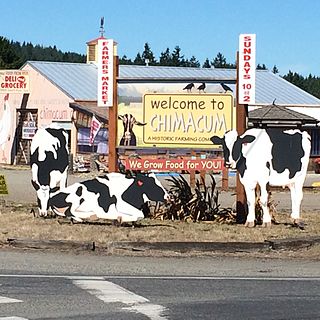
Chimacum is an unincorporated community in Jefferson County, Washington, United States, located in the center of the primary agricultural area of the eastern Olympic Peninsula.

The Wildwood Recreation Site is a natural recreation area surrounded by the Mount Hood National Forest in northern Oregon, United States. It encompasses 580 acres (230 ha) of old growth forest and five miles (8 km) of interpretive trail along the Salmon River. It features Cascade Streamwatch, an underwater viewport into a mountain stream bed and live fish habitat. There is a wetland boardwalk trail, and trail access to the nearby 70-square-mile (180 km2) Salmon-Huckleberry Wilderness, and the Sandy River.
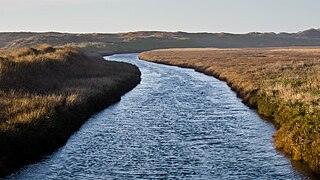
Pescadero Creek is a major stream in Santa Cruz and San Mateo counties in California, United States. At 26.6 miles (42.8 km), it is the longest stream in San Mateo County and flows all year from springs in the Santa Cruz Mountains. Its source is at 1,880 feet (570 m) above sea level on the western edge of Castle Rock State Park, with additional headwaters in Portola Redwoods State Park, and its course traverses Pescadero Creek County Park and San Mateo County Memorial Park before entering Pescadero Marsh Natural Preserve at Pescadero State Beach and thence to the Pacific Ocean 14.4 miles (23 km) south of Half Moon Bay.

Dam removal is the process of demolishing a dam, returning water flow to the river. Arguments for dam removal consider whether their negative effects outweigh their benefits. The benefits of dams include hydropower production, flood control, irrigation, and navigation. Negative effects of dams include environmental degradation, such as reduced primary productivity, loss of biodiversity, and declines in native species; some negative effects worsen as dams age, like structural weakness, reduced safety, sediment accumulation, and high maintenance expense. The rate of dam removals in the United States has increased over time, in part driven by dam age. As of 1996, 5,000 large dams around the world were more than 50 years old. In 2020, 85% percent of dams in the United States are more than 50 years old. In the United States roughly 900 dams were removed between 1990 and 2015, and by 2015, the rate was 50 to 60 per year. France and Canada have also completed significant removal projects. Japan's first removal, of the Arase Dam on the Kuma River, began in 2012 and was completed in 2017. A number of major dam removal projects have been motivated by environmental goals, particularly restoration of river habitat, native fish, and unique geomorphological features. For example, fish restoration motivated the Elwha Ecosystem Restoration and the dam removal on the river Allier, while recovery of both native fish and of travertine deposition motivated the restoration of Fossil Creek.
The Little Quilcene River is a river on the Olympic Peninsula in the U.S. state of Washington. It rises in Clallam County, near Mount Townsend of the Olympic Mountains.
The Donovan Creek Estuary lies on the Quilcene bay on the coast of Jefferson County, Washington in north-west Washington state on the Olympic Peninsula.
The Little Quilcene Estuary lies on the Quilcene bay on the coast of Jefferson County, Washington in north-west Washington state on the Olympic Peninsula.
The Heron House easement is an approximately 50-acre natural area protected by the Jefferson Land Trust on the Quilcene bay, including floodplain and tidelands, an estimated 1,300 ft of salt water frontage. It is located on the coast of Jefferson County, Washington in north-west Washington state on the Olympic Peninsula. The conservation area was acquired in 2010.
The Tarboo Unit is a North Olympic Wildlife Area, managed by the Washington Department of Fish and Wildlife, that lies 4.5 miles northeast of Quilcene, Washington at the top of Tarboo Bay. It is located on the coast of Jefferson County on the Olympic Peninsula in northwest Washington state. The conservation natural area is home to both deciduous and conifer forests and supports protected species such as bald eagle, northern spotted owl, and marbled murrelet.
References
- "Federal funds distributed for Lower Donovan Creek, other wetlands". Peninsula Daily News.
- "National Wetlands Conservation Grant Program". Washington State Department of Ecology. Archived from the original on 2010-11-03. Retrieved 2011-01-27.
- "Quilcene Bay Projects". Kitsap Sun. Archived from the original on 2012-03-08.
- "Big.Little Quilcene Estuary Restoration (03-03)".
- "A. Big Quilcene Estuary South Bank Levee Removal (03-03-011)".